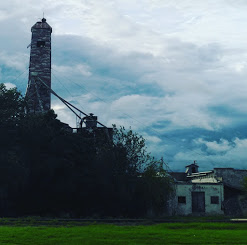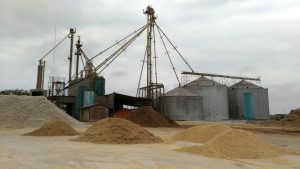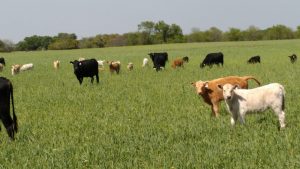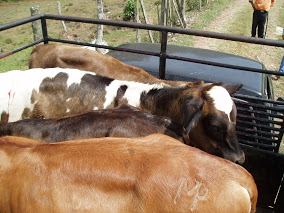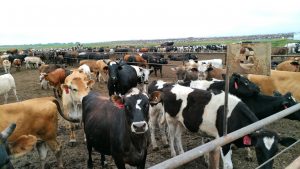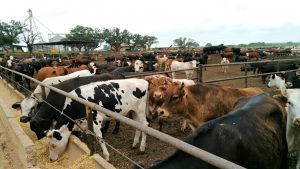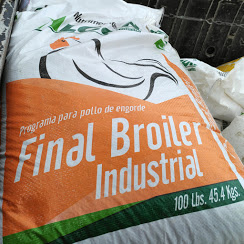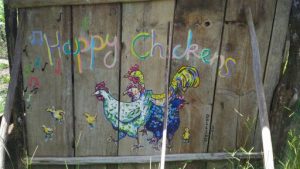I can’t move! I cannot move at all! I can’t move!! “Gene!” “Gene!!!”
“Oh my God, I am heartedly sorry …”
And then shortly after I had barely begun my act of contrition, it was total mental darkness and total silence! I went blank.
……………………………………………………………………..
I’d completed all my responsibilities at the little feed lot owned by the Tri-County Farmers Co-op in Devine, Texas which finished several hundreds of cattle at a time in the southwest corner of where Interstate 35 and Texas State Highway 173 join today. [That summer of 1964 after my senior year at Devine High and before starting at Texas A&M, my job was to take total care of these young bovine, many of which were shipped in on semi-trailer trucks from Florida and arrived in very poor health. I put out various rations from 100-pound burlap bags of feed, I raked the feed regularly in the troughs to keep it fresh and to keep the steers and heifers eating, I shot the sick animals with the appropriate dosage of combiotic, I implanted the ears of steers with diethylstilbestrol, and I maintained a “tidiness” of the grounds. … (By the way, diethylstilbestrol was banned in the 1970s because of numerous health risk red flags.)]
Therefore, since I’d done my work at the feed lot for the day, I rode west on 173 for a half-mile to across the tracks and to the mill and elevator of the co-op operation to help the mostly black and brown laborers in the making and bagging of feeds for sale. [This business was initially constructed and developed in the 1940s/50s by my L.C. (Peggy) Martin, my father’s older brother (by 11 years) … and his partners/investors. In the late 1950s or early 60s it was transitioned into a Farmland Enterprises cooperative which during various periods bought grains and other feedstuffs as components for livestock feeds, cleaned seeds and some edible dry beans and southern field peas, made and sold feeds, and sold fertilizers, pesticides, veterinary medication, tractors, and other farm and ranching supplies.]
Upon entering the main grinding, mixing and bagging area, I began to help Charles Eugene Haywood mix a ration for beef cattle. The conveyor belt for providing the cottonseed hulls component for the particular ration was running empty, and Gene told me to go to the area on that floor where one could punch with a rod the fibrous seed coats down to an opening below which funneled them to the belt system. Because I had done this task some days earlier, from that previous day’s experience I felt there weren’t enough hulls in the enormous bin for them to be reached with the rod from the upper floor. Therefore, I grabbed a scoop and went down into the basement which was mostly dark, with illumination from only a single incandescent bulb hanging down on a long electrical wire from the ceiling. Then I entered the hole in the wall which was the entrance to the cottonseed hull storage space from the basement, and I started shoveling. Unbeknownst to me, the mill had received a train car load of cottonseed hulls while I worked for several days at the feedlot and the old corn bin now serving to contain the empty cottonseeds was packed full. In fact, it was so packed that a small cave had formed just inside and in the lower area where I entered and where the hulls fed from the bin to the conveyer belt. It only took a single shoveling action to bring seven-foot* (according to the next day’s story in the S.A. Express-News) of packed cottonseed hulls on top of my young body.
“Mr. Doyal, I told Paul Bain to get some cottonseed hulls a-flowing to us for making this ration, but nothing ever came up the conveyer belt!? I went down in the basement to find him, but all I saw was a cottonseed bin clogged with hulls.” “He must be in there!” shouted Mr. Odis Doyal, the plant foreman. They screamed for the machinery to be shut down, and the whole of the mill hands hurried to dig for my body. Gene dug from the ground floor, and his older brother Ed Lacy from the opening down in the basement. “Here’s his cap.” hollered Lacy.” “I’ve got his foot. Help me pull him out.” “Damn, he’s as blue as a pair of new jeans.” “Here, let’s get him up on Pepe’s shoulders and get him out of this dark basement and work on him.” (Recently my sister Linda told me that a coworker of Don Lawrence–Devine’s “defacto ‘EMT'” in those days–related to her that the color he used for me when he first saw me after this accident, was purple.)
………………………………………………………………………….
I awoke under an oxygen tent in Santa Rosa Hospital, San Antonio to the assertive voice of the feisty little bantam rooster of a woman–one of my Dad’s four sisters, Aunt Lora McLennan. “I don’t care what this hospital’s policy is. He’s my brother Alton’s oldest son, and I’m going in.”
“Hmm. You don’t look so good!” she exclaimed as she surveyed the lacerations on my head and the big gap in my teeth.” “You are very lucky to be alive!”
Later after the numerous visits of co-workers, family and friends, I began to get other pieces of the story of this not-so-good-a-day at the Mill in Devine. … As Pepe Garcia was carrying me up the concrete steps from the basement*, someone exclaimed, “He’s dead!! He’s dead!!” Not wanting to have anything to do with a dead man, Pepe tossed me off his shoulder, and I landed on the concrete floor below.
Lacy picked me up and carried me outside to along the railroad tracks. Mr. Doyal began to scoop the hulls out of my mouth, and when they were removed, I clamped down on his fingers. In pain he jerked them from my boca, and my teeth preceded to remove skin from his rugged dactyls. (He showed me two of his skinned fingers when he visited me in the hospital.)
Then Mr. Claude Fuquay, the Co-op manager, grabbed a stick with which to pry open my mouth, and very cleanly out came my lower right lateral incisor, complete root and all. All of the folk from the mill and mill store worked to get out as many hulls as they could while they waited for Devine’s medical transport service person, Don Lawrence, and his transport vehicle*. (Luckily, Dad Alton, who worked primarily as a clerk and salesperson in the mill store, had taken an afternoon coffee break and was spared some of the drama. He joined the group working on me there on the ground near the railroad tracks about the time Don Lawrence and his ambulance arrived.)
I was taken to Dr. Peters’ clinic on the other side of Devine where I was given oxygen. I very vaguely remember fighting Dr. Peters and Dad when they were trying to exchange oxygen masks in the ambulance, but then totally passed out again until Aunt Lora woke me in the Santa Rosa in downtown S.A.
My Mom has told me that the respiratory specialist-doctor and surgeon who removed most of the rest of the hulls from my pharynx, trachea, and bronchi with forceps-like tools, tubes, and suction, and the aid of an X-ray machine, … was leaving the hospital for home when he was paged. He confessed to Mom that he started to ignore the call, but thankfully he suddenly decided he’d better turn around and respond.
This accident occurred in August of 1964. In early November I worked the A&M bonfire with temporary caps over the two teeth which had been drilled down to serve as supporting piers for the bridge my dentist in Pearsall was making. I remember sharp pains from the cold air which swirled under the caps as I helped transport logs during bonfire preparations for that football season in which the Ags won but one game (and not against tu, but against SMU).
I coughed up the last hull in my respiratory tract in February of 1965.
********************************************
There are perhaps at least three major take-aways this story:
• It is likely that if we had already had the Occupational Safety and Health Act of 1970, I would have been able to see down in that dark and cluttered basement and even into the cottonseed hull storage area. Moreover, I might have received some training which discouraged my going without a partner to perform what was a relatively dangerous task. Of course, we would have needed actual OSHA enforcement also. In today’s world the governmental regulatory inspectors and system is outnumbered and overwhelmed by neoliberal capitalistic corporations and their marketing and propaganda.
• Gene and Mr. Doyal did quickly recognize a serious life-threatening situation in the noisy chaotic industrial agricultural enterprise, and along with others as a team they took some very appropriate and well-thought out and solid actions to save a young member of community.
• God and prayer didn’t save me. Human critical thinking and the quick actions of Gene Haywood et al. saved me. I was lucky that Pepe dropped me from up on the steps which knocked hulls loose and jarred my respiratory and cardio-vascular system and helped to save me. Alton and Louise Martin genetics and rearing saved me because I did have a strong desire to keep on living. Kinesiology and sports of the Devine ISD and a holistically healthy lifestyle on our little farm just outside of Devine resulted in a healthy body, and this helped save me. Don Lawrence, a very valuable and conscientious citizen of community, Dr. Peters, a wonderful health practitioner, and a medical doctor and staff at the wonderful Santa Rosa saved me.
[*As I write this, I am hoping I might find the S.A. Express-News clipping covering this crazy incident—which Mom had given me years ago. And I think next time I travel to Devine to visit, I’ll ask Bill Hope, current owner of the dilapidated old mill if I can go back and investigate “the scene of the crime”. Finally, I’d like to know more about Don Lawrence and others involved in saving my life.]
Epilogue
• My senior year I was lucky (And it was luck! Of six finalists at the regional meet at TX A&I, one got sick & dropped out, one tripped over the concrete curb inside the first lane, June Butler, State Champ in 1963 pulled a thigh muscle, & I did beat one healthy finalist.) to get second place in the regional track meet in the 440-yard dash, and travel to Austin with Bob Bendele to compete in the state meet. Moreover, I did receive several academic and non-academic awards and honors.
• I received three degrees in agricultural entomology from Texas A&M and University of Florida, did research on insects for about 15 years, taught in the Natural Sciences Department, St. Philip’s College for ca. 22 years, and served with the Texas Department of Agriculture for ca. 7 years. I have numerous scientific-, outreach-, and advocacy-type publications, and have received (not really deserved) awards concerning the successful securing of grants, teaching achievements, and humanitarian volunteer work.
• Nevertheless, a common response back home when I reintroduce myself to someone is, “Oh yeah! you’re the fellow who almost died after being covered with cottonseed hulls at the Mill.” In fact, once when I went into Medina County Commissioners Court to ask for collaboration in an agriculture activity while I worked with the Texas Department of Agriculture, Judge Butchy Campsey, presented me as “Oh y’all remember Paul Martin?! He was the one who was in the cottonseed hull accident at the Mill in Devine.” The cottonseed hull incident is the only thing many folk in my home town remember or know about me, a very famous (maybe infamous) scientist and activist who rivals the fame of Donald Trump.
7Ss / VV->^^
pbm
